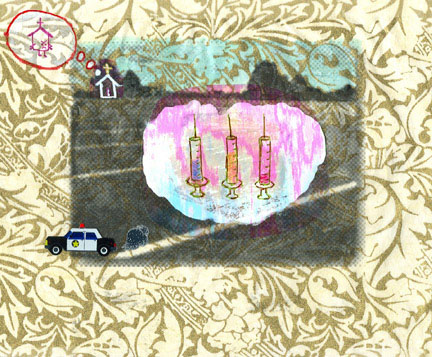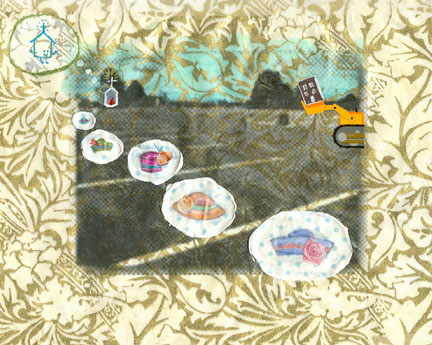|
By Lee Chilcote
Illustrations by Corrie Slawson and Amber Anderson
 |
| “Pastor,
there are empty syringes in your parking lot,” the phone
call begins. “It’s really bad. There’s a lot
of drugs going on over there.” |
“Pastor, there are empty syringes in your parking
lot,” the phone call begins. “It’s really bad.
There’s a lot of drugs going on over there.”
Sitting in his office at Bethany Baptist Church, Reverend
Steve Rowan sighs heavily and leans his head on his hand while the
rest of last night’s voicemail message plays. There’s
a pause, then the caller, who sounds like she could be older and
African-American, adds hopefully, “Maybe if you talk to the
councilwoman, she’ll listen to you.”
She hangs up. No name, no phone number.
Rev. Rowan plays the message for me when I ask him what kind of
community problems he sees, and what the churches are doing to help.
From the look on his face, clearly Rowan, head pastor at Bethany,
is disturbed by the message. But, he says he’s helpless to
do anything, other than make a phone call to the councilwoman or
the police commander, and will that help? Instead, he shares the
story of how the church acquired the parking lot across the street
years ago.
“We needed more parking, and there was an abandoned
building,” he says. “We knew we had to get the building
so that someone else didn’t get it. It was in bad shape –
basically gutted. People were doing things they shouldn’t
have been doing in there.”
Bethany Baptist Church is on East 105th Street between
St. Clair and Superior, in the heart of Glenville. The cost of renovation
just didn’t make sense because of the building’s condition
and lack of demand, Rowan says. So, Bethany tore it down and removed
the foundation, banking the land for a time when the market demanded
a new use for the property.
“I know that sometimes churches are a bane to
community development corporations because they’d like to
see bricks and mortar, something built on the street,” he
says. “Parking is a huge issue in inner city churches –
people want a safe place to park when they come to church.”
Rowan insists that site control was key to the expansion of Bethany’s
ministry. His perspective is informed by twenty years as a lawyer
at Ulmer and Berne, and in economic development at Cuyahoga County
and the Cleveland Foundation. He is only the fourth pastor in the
church’s 80-year history. His father, Steve Rowan Sr., was
the former minister, and when he died in 2000, his son “accepted
the call.”
In truth, though Rowan may have left the field of economic development,
these experiences will serve him well at Bethany. The tension between
expanding churches and an impoverished neighborhood are at the heart
of challenges faced by E. 105th, Glenville and Cleveland.
 |
| Night and day. That’s the difference
between E. 105th on a Sunday, and on any other day of the week.
On Sunday, the street teems with cars, and people in suits,
dresses and flashy hats cross the street to church. |
Night and day. That’s the difference between
E. 105th on a Sunday, and on any other day of the week. On Sunday,
the street teems with cars, and people in suits, dresses and flashy
hats cross the street to church.
On almost any other day, “One Oh Five,”
as the neighbors call it, buzzes with a different sort of activity
– kids walking home from school, adults going to the corner
store, sometimes a young man standing on the street dealing drugs.
Besides churches, there’s a hodgepodge of parking lots, boarded
up buildings, and convenience stores. Although many of the churches
stay active during the week, their parking lots are rarely full.
These churches are anchors of the Glenville neighborhood in many
ways. For their congregants that live outside of the neighborhood,
they provide a reason to return. For those that live in the neighborhood,
they provide a reason to stay, and a host of services. In addition
to worship services on Sundays, Bethany also runs a food bank, a
day care center, after school programs, basketball teams, and much
more. Many of them also feature gorgeous, irreplaceable architecture.
Yet while churches are often a resource to solving
neighborhood problems, some Glenville observers don’t see
it that way.
“We have fifteen or more churches on 105th,” says Tony
Diggs, Community Outreach Coordinator for the Glenville Development
Corporation. “Every third block has a church, and each one
needs its own parking. This isn’t the best land use for the
area – it doesn’t serve the community in terms of commercial
development.”
Diggs smiles wryly and shakes his head. “The fact is,”
says Diggs, adding that Glenville Development does not necessarily
share his beliefs, “if we were opening up businesses at the
same rate as churches, we wouldn’t have a community development
problem.”
A land-use survey of East 105th St. reveals that Diggs is not exaggerating.
More than 50 percent of the street between St. Clair and Superior
is owned by churches, according to city of Cleveland records. To
accommodate parking, many of these institutions have bought up chunks
of land adjacent to or across the street from their buildings. Many
are also spiritual powerhouses in the African-American community,
including Cory Methodist Church, Greater Abyssinia Baptist Church,
Bethany Baptist Church, Cleveland Church of Christ, Apostolic Faith
Tabernacle and Lee Memorial Baptist Church.
Apparently, this situation – urban churches facing a tension
between serving the needs of their surrounding communities, and
the needs of their congregants – is not uncommon.
“Many city churches are actively involved in community development,”
says Mike Tevesz, Director of the Center for Sacred Landmarks at
the Levin College of Urban Affairs at Cleveland State University.
“They become magnets and anchors for activity, providing services
such as child care, or engaging in housing development. They are
a kind of ‘unseen resource’ in their neighborhoods.”
Yet churches are not always sensitive to the needs of their communities,
he says. “The question would be, do the congregants come from
the neighborhood, or from a greater distance? If they are coming
from outside of the neighborhood, then it’s possible that
the church would be more responsive to the needs of the congregants.”
Cory Methodist Church, a beautiful stone building originally built
as a Jewish temple, is one church with a mixture of congregants
that live in the neighborhood, and outside of it. Cory offers many
community services, including a seniors program, hunger center,
food kitchen, credit union, head start program, computer classes
and a jobs program. The church, built with a full gymnasium and
swimming pool, also houses a city recreation center.
Reverend Orlando Chaffee, the head pastor at Cory, cites his church’s
programs as a part of an effort to address neighborhood problems.
“The biggest issue is a lack of positive alternatives for
youth to just hanging out on the street,” he says. Other problems
include crime and drugs, and the need to create more home ownership
in the neighborhood, he says.
A disconnect exists between church and neighborhood, accentuated
by Glenville’s issues with poverty, safety, declining housing
stock, Diggs offers. Some parishioners have moved out of Glenville,
he adds, and this has heightened the problem.
“East 105th is pretty much owned and operated by churches,”
says Diggs. “So if we’re going to have economic development,
it won’t happen unless the churches choose to make it a part
of what they do.”
Diggs has an idea for a remedy, an idea he calls “God’s
Roundtable.” It’s a forum for churches to come together
to work on community problems. Currently, Diggs is contacting churches
to get this started; Bethany is helping out with this fledgling
effort.
Chaffee expressed an interest in the Roundtable, but says that he
“doesn’t see churches on the street giving up parking,
because they know that if they don’t provide parking on Sunday,
people won’t come.”
The real community development problem, he says, is not so much
that churches are hogging the land, but that it’s hard to
find people willing to invest. And if churches bought up and tore
down buildings to create parking lots, then they have also removed
eyesores from the street. Cory, for example, fought to close down
Eagle Market, a store across from the church, by protesting its
liquor license. This is a double-edged sword, because now the building
remains stubbornly vacant, and is slowly deteriorating.
“It’s hard to get churches together unless there’s
a crisis,” Chaffee says. “And many are doing all they
can to keep their buildings open. They don’t have extra income
to do economic development, and may not see it as part of what they’re
called to do.”
Diggs maintains that the long-range future of East 105th is as a
mixed-use district of churches, housing and small businesses. Major
commercial businesses, he argues, should not be located here, but
rather on Superior and St. Clair. He cites Glenville Plaza, a newer
shopping strip completed in the 1990s at E. 105th and St. Clair,
as an example of successful commercial development on these major
thoroughfares.
Further south on E. 105th, the non-profit Famicos Foundation has
undertaken a comparable effort to remake the street. In an ambitious
conversion of E. 105th between Wade Park and Superior, the group
has rehabbed historic homes and is constructing new townhouses where
dilapidated buildings once stood.
Could a similar development happen on E. 105th between St. Clair
and Superior? None has been proposed yet. The first meeting of “God’s
Roundtable” is set for this spring, and it’s likely
the parking issue will surface.
It’s probable that, to create off-street parking
behind the churches, some of the houses on the adjacent side streets
would have to be torn down. Would Bethany look at a proposal like
this? I ask Reverend Rowan.
“Sure,” he says, nodding his head. “We’d
have to acquire the property first, and it would have to make economic
sense.”
He remarks wistfully that he’d like to get Bethany involved
in development, perhaps in collaboration with other churches or
a CDC. “I’d like to see a family life center, some place
dedicated to personal development for youth,” he says. “A
place to serve all generations in the neighborhood. Or some kind
of center for small businesses, a place that would create some jobs.”
Rowan leans back in his chair and lifts up his hands. “This
kind of development – it’s hard for churches to do,”
he says. For now, it seems unlikely that change will happen quickly
on E. 105th – but the door is open.
“We want to be a beacon of light in the darkness,” he
says. “There’s strength in numbers. I’m always
looking for collaboration.”
 |
| “We
want to be a beacon of light in the darkness,” he says.
“There’s strength in numbers. I’m always looking
for collaboration.” |
Bruce home
|




![]() Also in this issue's Feature Well...
Also in this issue's Feature Well...


